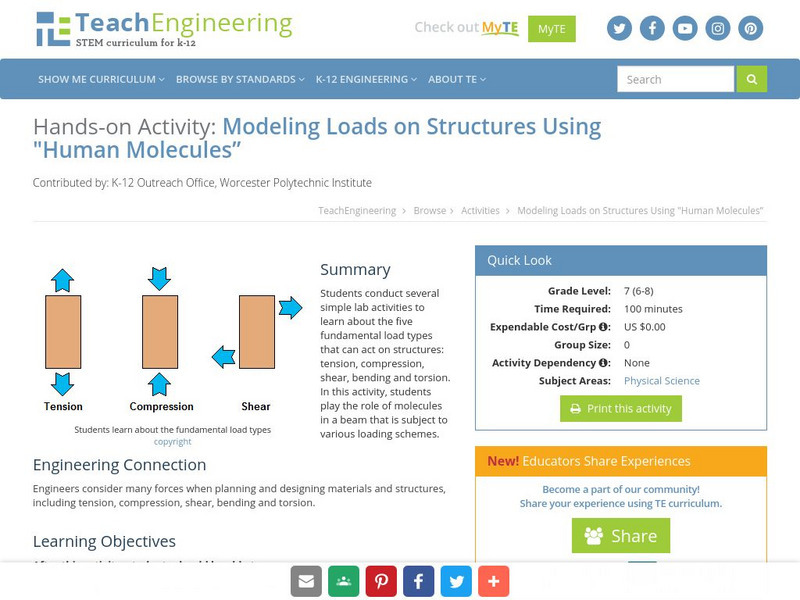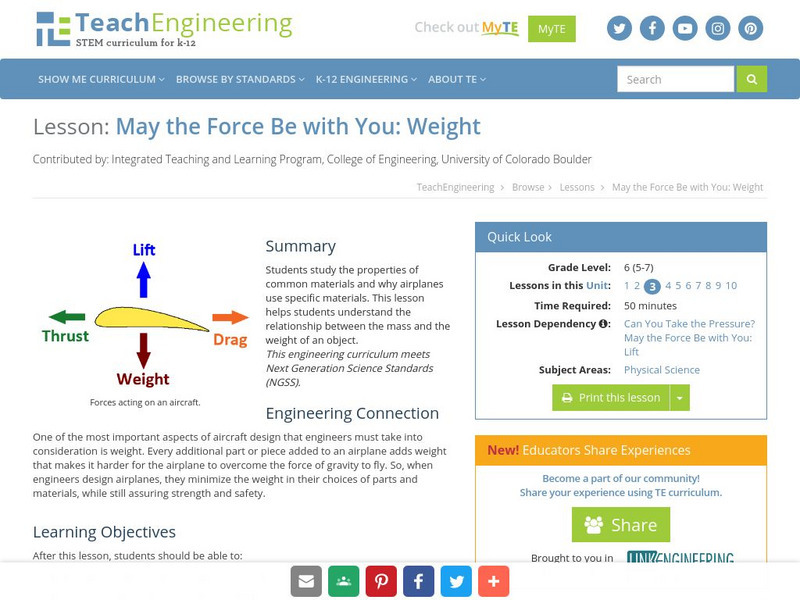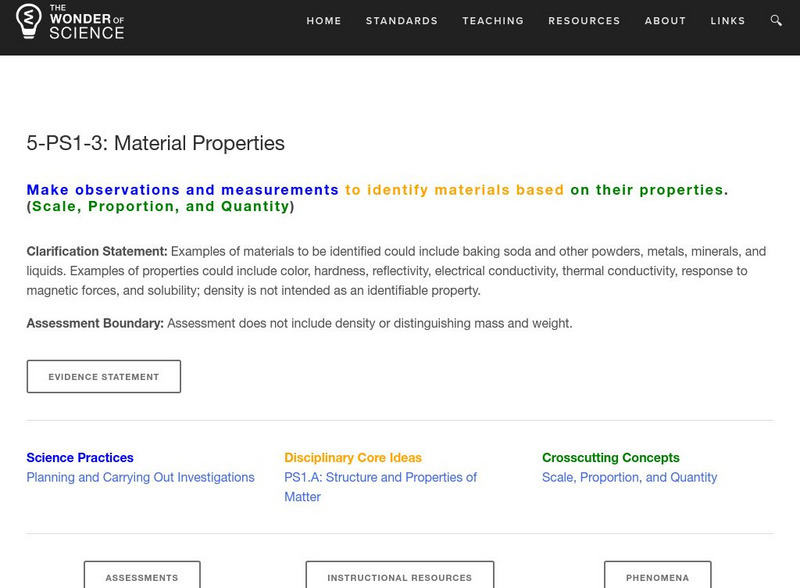TeachEngineering
Teach Engineering: Ball Bounce Experiment
Many of today's popular sports are based around the use of a ball, yet none are completely alike. In fact they are all designed with specific characteristics in mind. Students will investigate different balls' abilities to bounce and...
TeachEngineering
Teach Engineering: Compare Fabric Materials
Students will look at different types of fabric and their respective individual properties. Using a magnifying glass and sandpaper they will test and observe the weave of fabrics and the wear quality of sample fabrics. By comparing the...
TeachEngineering
Teach Engineering: Forces on the Human Molecule
Students will conduct several simple lab activities to learn about the five fundamental load types that can act on structures: tension, compression, shear, bending, and torsion. In this activity, students will play the role of molecules...
TeachEngineering
Teach Engineering: May the Force Be With You: Weight
The purpose of this lesson is to help students understand the relationship between the mass and the weight of an object. Students will study the properties of common materials and why airplanes use specific materials.
TeachEngineering
Teach Engineering: Stressed and Strained
Students are introduced to the concepts of stress and strain with examples that illustrate the characteristics and importance of these forces in our everyday lives. They explore the factors that affect stress, why engineers need to know...
TeachEngineering
Teach Engineering: Design Packing to Safely Mail Raw Spaghetti
Students will use their creative skills to determine a way to mail raw spaghetti. The students will need to choose a way to safely package their raw spaghetti using only the materials provided. To test the packing designs, the spaghetti...
TeachEngineering
Teach Engineering: Design a Bicycle Helmet
The goal of the activities is for students to understand the basics of engineering associated with safety products. Using a bicycle helmet helps to protect the brain and neck during a crash. In order to do this effectively, helmets must...
E-learning for Kids
E Learning for Kids: Science: Loch Ness: What Properties Do Materials Have?
This lesson looks at how the physical properties of materials determine how they can be used, and students decide which materials are strong, hard, soft, or transparent.
Science Struck
Science Struck: Difference Between Plastic and Elastic Deformation
Clearly explains the characteristics of elastic and plastic deformation and the differences between them.
The Wonder of Science
The Wonder of Science: 5 Ps1 3: Material Properties
Work samples, phenomena, assessment templates, and videos that directly address standard 5-PS1-3: material properties.
Education.com
Education.com: Sorting Objects by Material
[Free Registration/Login Required] This game challenges kids to sort objects by material. Taking their cues from the Three Little Pigs, preschoolers will sort items made of straw into one backpack, sticks into another, and bricks into a...
TED Talks
Ted: Ted Ed: Which Is Stronger: Glue or Tape?
Elizabeth Cox explores the world of adhesives, comparing glue to tape.
Other
Educational Innovations: Diaper Polymer Activities [Pdf]
What can you do with diaper polymer? Check out these six quick student experiments involving the chemical used in diapers.
Other
American Chemistry Council: History of Polymers & Plastics for Teachers
This resource presents a teacher guide that offers information on the history, structure, characteristics, forms, and common uses of plastics and polymers.
Other
American Chemistry Council: History of Polymer and Plastics for Students
This resource presents a brief guide introduces the history, structure, and characteristics of plastics and polymers.
PBS
Pbs Learning Media: The Ruff Ruffman Show: Rainbow Popsicle
Explore kitchen chemistry and make a cool rainbow popsicle.
Concord Consortium
Concord Consortium: Quantum Tunneling
Delve into a microscopic world working with models that show how electron waves can tunnel through certain types of barriers. Learn about the novel devices and apparatuses that have been invented using this concept. Discover how...
Stanford University
Stanford University: Pour It Out
Students learn how material properties change as the size of the material decreases to the nanoscale. This lesson investigates the effects of forces at different scales.
PBS
Pbs Learning Media: The Ruff Ruffman Show: Photo Stuff With Ruff
Discover what the "stuff" in your world is made of in this camera-based app experience from The Ruff Ruffman Show.
PBS
Pbs Learning Media: The Ruff Ruffman Show: Dress That Rhino
Use science inquiry to explore, test, and document material properties to help dress up Fluff the Rhino for Ruff's pet-sitting adventures.
PBS
Pbs Learning Media: The Ruff Ruffman Show: What Should Fluff Wear?
Help Fluff the Rhino dress for a trip in this activity from The Ruff Ruffman Show. Fluff will need different clothing.
Science Fun for Everyone
Science Fun: Olympic Medals
Create your own Olympic medal out of clay with the help of an adult. Watch as your design hardens over time as the water in the clay evaporates.
Science Buddies
Science Buddies: Build the Best Paper Bridge
Find out what makes a bridge strong in this fun activity as you build simple bridges with paper and test to see how much weight they can hold.
ClassFlow
Class Flow: Resources: Characteristics of Materials
[Free Registration/Login Required] Through this unit children should extend their knowledge of the range of materials we use and of the properties that characterize them. This knowledge should help them recognize what needs to be...

















